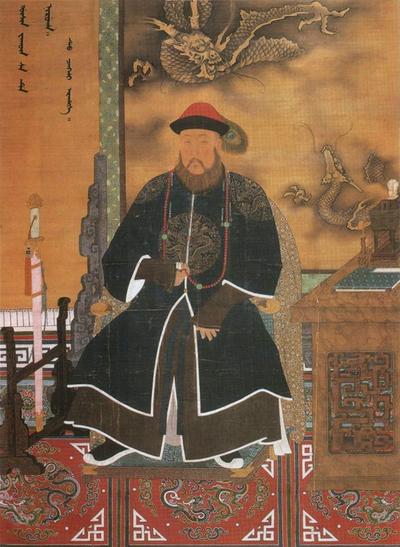
Dorgon
| Name | Dorgon |
| Title | Prince Rui of the First Rank and regent of the Qing Dynasty (1612-1650) |
| Gender | Male |
| Birthday | 1612-11-17 |
| nationality | Qing dynasty |
| Source | https://www.wikidata.org/wiki/Q380573 |
| pptrace | View Family Tree |
| LastUpdate | 2025-10-27T03:41:13.831Z |
Introduction
Dorgon (17 November 1612 – 31 December 1650) was a Manchu prince and regent during the early Qing dynasty. He was born into the Aisin-Gioro clan as the fourteenth son of Nurhaci, the founder of the Later Jin dynasty, which preceded the Qing dynasty. His mother was Lady Abahai, Nurhaci's primary consort. Dorgon had full brothers Ajige and Dodo, and a half-brother Hong Taiji, Nurhaci's eighth son.
Dorgon's early career involved military campaigns against Mongol groups, the Korean Joseon dynasty, and the Ming dynasty. His participation in battles against the Chahar Mongols occurred in 1628 and 1635. Under Hong Taiji's reign, he played a significant role in consolidating Manchu control and expanding territory.
Following Hong Taiji's death in 1643, Dorgon was involved in a succession dispute with Hong Taiji's eldest son, Hooge. The conflict was resolved with a compromise: Hong Taiji's ninth son, Fulin, was installed as the Shunzhi Emperor, with Dorgon and Jirgalang appointed as co-regents. Dorgon was granted titles recognizing his regency, initially as "Prince-Regent" and later as "Emperor's Uncle and Prince-Regent" in 1645, subsequently changing to "Emperor's Father and Prince-Regent" in 1649.
During his regency from 1643 to 1650, Dorgon directed military efforts to solidify Qing control over China. Under his leadership, Qing forces captured Beijing, the Ming capital, and subdued Ming loyalist resistance across the country. Notably, the Qing occupied Beijing in October 1644 after the fall of the Ming dynasty's last emperor, Chongzhen, who committed suicide.
Dorgon oversaw the occupation and administration of Beijing, implementing policies such as enforcing a hairstyle of shaving the front of Han Chinese men’s heads and tying their hair in queues, aligning Han customs with Manchu traditions. He also ordered the distribution of territorial land among Banner troops and promoted efforts to integrate Han Chinese into Qing rule.
He contributed to the military campaigns against Ming loyalists, including the conquest of Xi'an in Shaanxi Province in early 1645 and the suppression of Southern Ming regimes. Major battles included the siege and fall of Yangzhou in May 1645, where Qing forces, under Dorogon's command, killed a large portion of the city's population to ensure control. The Qing expansion into southern China continued through 1649 and 1650, with campaigns in Jiangnan and Guangzhou, and efforts to eliminate remaining Ming loyalist factions, such as the Yongli Emperor's regime.
Dorgon ordered the reestablishment of the imperial civil service examinations in 1646, with the first held in the same year. Policies aimed at ethnic integration included allowing Han Chinese men to marry Manchu women from the banners with official approval, fostering intra-ethnic relations.
Dorgon died on 31 December 1650 during a hunting trip in Kharahotun (present-day Chengde, Hebei). After his death, he was posthumously honored as an emperor with the temple name "Chengzong" and the title "Emperor Yi," although he was never officially an emperor during his lifetime. His death was surrounded by speculation of possible murder, as the official account cited fatal injuries from a horseback accident, though some historians question this narrative.
In 1651, following political shifts, Dorgon's titles were revoked, and he was posthumously demoted amid accusations by his political rivals. These charges, including alleged plots to seize the throne, were later overturned during the reign of the Qianlong Emperor in 1778, who rehabilitated Dorgon's reputation and granted him a posthumous name meaning "loyal." His remains were exhumed, and records related to his downfall were destroyed under the Qianlong restoration.
Dorgon's appearance was described by Japanese travelers as tall and slim, with a handsome visage, dark skin, sharp eyes, and a distinctive beard. His family included multiple consorts from the Khorchin Borjigit, Tunggiya, and Zha'ermang clans, and he had a daughter named Donggo.
He has been portrayed in various media, including Korean, Chinese, and Japanese television series and films, notably in "Daemyeong" (1981), "War of the Arrows" (2011), "Rule the World" (2017), and "The Legend of Xiao Zhuang."
Dorgon’s historical role is recognized as instrumental in the Qing conquest of China, although his policies and actions also contributed to significant upheaval and resistance during the early Qing expansion period.
Family Tree
Tap to expand more relatives